
Phylum Arthropoda(O and A-level biology)

Arthropods
General characteristics
- have segments bodies
- have exoskeleton
- have jointed legs
- they have a dorsal heart with an open vascular system
They are divided into five classes
- crustacea
- chilopoda
- diplopoda
- arachinida
- insecta
Class crustacean
Characteristic
- have two compound eyes
- mostly aquatic
- have five or more pairs of legs.
Examples

Economic importance
Source of food to man and other animals
Few are parasitic
Class Chilopoda
Characteristics
Have cylindrical bodies with numerous segments each with one pair of leg.
Carnivorous
Example
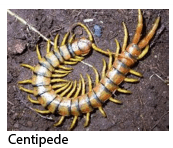
Class Diplopoda
Characteristics
- their bodies are cylindrical with numerous segments that are similar except around the head region.
- Each segment has two pair of walking legs
Example

Adaptations of millipedes to the environment
- Exoskeleton prevents excess water loss.
- It has a dark color for camouflage from predators.
- Have eyes to see food and predators.
- Have legs for locomotion to look for food and run away from predators.
- Has strong mandibles for chewing.
The detailed structure of the head of a millipede

Adaptations of the head of a millipede to survival of organism
- Eyes to see food
- Strong mandibles for feeding
- Antennae for feeling
Economic importance
- Millipedes are herbivores and pest to farm crops.
- They burrow and aerate the soil and improve drainage.
Class Arachnida
Characteristics
- the body is divided into two main body parts, cephalothorax and abdomen
- have no antennae
- have four walking legs on cephalothorax
Examples

Economic importance
- Tick and mites are parasites to domestic animals
- Tick spreads diseases to man e.g. coastal fever
- Spiders feed on vectors.
- Scorpions and spiders inflict fetal stings
Adaptations of the tick to the mode of life
- Hard cuticle to prevent water loss and protects in parts
- Has dark color for camouflage
- Has strong teeth to cling on the host
- Has eyes to look for host.
Class Insecta
Characteristics
- has three main body parts; head, thorax, and abdomen.
- It has three pairs of legs.
- Thorax is divided into pro-, meso-, and metathorax.
Common insects include
Housefly
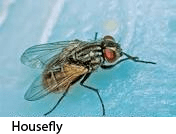
Order: Diptera
Characteristics of order Diptera
- one pair of wings
- hind wings are reduced to small knob-like structures or halters for balancing.
Characteristics of housefly
- has a pair of compound eyes for vision
- has expanded or club-shaped proboscis
- has simple eyes (Ocelli)
- has a pair of wings and a pair of halters.
- The body is hairy.
- Has a pair of short hairy antenna
A drawing of housefly mouthparts

- maxillary pulps are flexible for handling and tasting food.
- Proboscis is expanded to increase absorptive surface.
- Proboscis is tubular to suck liquid food
A drawing showing the tarsus of the hind limb of a housefly
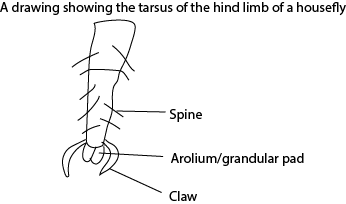
Ecological significance of the structures of tarsus of a housefly
- claw are for griping on to the surface during walking
- hairs increase sensitivity
- jointed legs increase flexibility
- Arolium secretes a sticky substance that allows them to stick on the smooth surface during walking.
Life cycle of a housefly
Has a complete life cycle.i.e.

Economic importance
Transmits diseases e.g. dysentery, cholera, trachoma, typhoid fever and poliomyelitis.
Control
General cleanness and hygiene
Cover food
Eat hot food.
Use insecticides.
Cockroach
Order: Diptera
Characteristics of the order
- has biting mouthparts
- has threadlike antennae
- has a pair of anal cerci
Characteristics of a cockroach
Has a long dorso-ventrally flattened body.
Has three main body parts: head, thorax, abdomen.
The head of cockroach
It is triangular

Adaptations of the cockroach head for its ecology
- has two pairs of compound eyes dorsolaterally located on the head for a large angle of vision.
- Ha modified mouthparts with strong mandibles for feeding
- Has a pair of long antennae for sensitivity
- the antennae are segmented to increase flexibility
- tapers from the head to reduce weight.
- Antennae are hairy to increase sensitivity
- Has broad base for firm attachment
- the thorax has two pairs of legs

Adaptations of hind limb to its function
- jointed for flexibility during movement.
- Long for quick movement.
- Has spine for defense: to pinch the enemy.
- Has areola to grip on smooth surface during movement.
- Has claws to grip cracked surface during movement.
Wings
The cockroach has two pairs of wings, outer and inner wing
Differences between outer and inner wings
| Outer wing | Inner wing |
| 1. Dark-colored 2. inflexible 3. not folded 4. Thick 5. narrow 6. opaque |
1. Light in color 2. flexible 3. folded 4. membranous 5. broad 6.transparent |
Adaptations of outer wings to their function
- it is hard or stiff for protection
- dull / dark colored for camouflage
- slippery for protection against the grip of predator
- has veins for strengthening the wing
Adaptations of the inner wings to their functions
- broad to generate repulsive force for flight
- flexible not to break in strong wing
- has veins for circulation of gases and strengthening the wing
Identifications of the sex of a cockroach
Structures on the ventral side of the last segments are used:

The male cockroach has styles while female cockroach has podical plates.

Functions of mouthparts of a cockroach
A table below shows the functions and adaptations of the mouthparts of a cockroach
| Parts | Functions | Adaptations |
| Mandible | Cutting and masticating food | Strong and sharp edges |
| Maxillae | Cutting and chewing food | Have sharp edges |
| Maxillary palp | Taste food | sensitive to food, jointed for flexibility, hairy to increase sensitivity |
| labium | Taste food | Hairy to increase sensitivity |
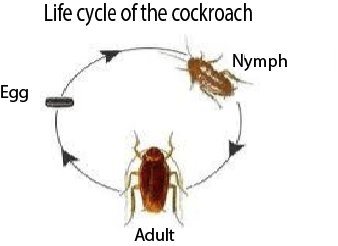
Economic importance of cockroaches
- Transmit germs from the toilets
- Their feces stain clothes
- Destroy document and clothes
Bee
Order: Hymenoptera
Characteristics of the order
- have two pairs of membranous wings
- have a waist between the thorax and abdomen
- They live in colonies

Other characteristics of the bees
- have hairy bodies
- has segmented, smooth (without hairs) uniform-sized antennae.
- Has a pair of compound eyes
Mouthparts
Consist of elongated proboscis tapering towards the apex, blunt-ended mandible; the labial pulp is segmented.
A drawing of the mouthparts of the bee
Thorax of a bee
- Bears 3 pairs of legs
- Has hymen between the thorax and abdomen
- The third pair of legs have the tibia deeply grooved to form a pollen basket that retain pollen
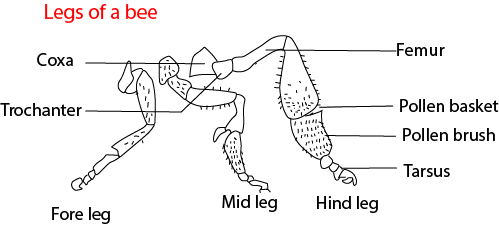
Abdomen
- abdomen constricts anteriorly to form a waist but tapers at the posterior end
- the last segment has a sting
- it is hairy
Differences between a bee and a housefly
| Bee | Housefly |
| 2pairs of wings | One pair of wings |
| Lack halteres | Has a pair of halteres |
| The hind limb has pollen basket | Hind limbs lack pollen basket |
| Has enlarged /thickened tibia | Tibia shorter/not enlarged |
| Abdomen cuticle thickened/hardened | Abdomen cuticle thin |
| Has proboscis and mandible | Has only proboscis |
| Pointed proboscis | Expanded proboscis |
| Has sting on last segment of abdomen | Lacks sting |
| Has no simple eyes | Has simple eyes |
| Has tapering abdomen | Has rounded abdomen |
Order: Isoptera
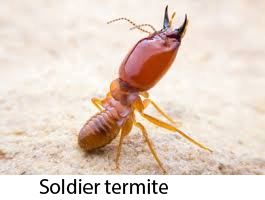

Characteristics of the soldier termite
– It has a massive enlarged head with
* prominent sharp mandibles for cutting food and defense.
* short segmented antennae.
* long segmented maxillary palps
– has a flattened body.
– has a smooth body without hair.

Economic importance
- turns the soil over to keep it loose and aerated
- source of food
- destroy wooded properties
- destroy plants
Worker termite
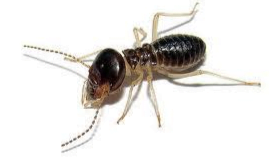
Order: isopteran
Characteristics
- Has biting mouthparts.
- Lack compound eyes.
- It has three pairs of legs.
- Has a rounded abdomen
- It’s dark for camouflage
Grasshopper
Order: orthoptera
– has threadlike antennae
– It has a pair of anal cerci.
Shape and appearance
The body is laterally flattened and tapering posteriorly.
Significance
- the lateral flatness enables the grasshopper to penetrate grass for hiding away from predators.
- The tapering nature makes the grasshopper streamlined.
Appearance
- some are green while others have shades of grey and brown for hiding.
- The exoskeleton is a waxy to reduce water loss.
The head
- It has big compound eyes for effective sight and wide field of view.
- Long antennae sense far objects.
- Has biting mouthparts for effective feeding.
- It has strong mandibles for cutting food and energy.

Adaptations of hind limbs to its function
- muscles to create a repulsive force during movement
- jointed for flexibility
- long for quick movement
- areolium allow grip on a smooth surface
- craws enable the grasshopper to grip to the cracked surface
- spines pinch the enemy during the defense
Difference between the hind limbs of a bee and grasshopper
| Hind limb of grasshopper | Hind limb of a bee |
| No pollen basket | Has pollen basket |
| No pollen comb | Has pollen comb |
| Has spine | Has no spines |
| hairless | Has hairs |
| Thick and expanded femur | Has thin and short femur |
Wasp
Order: hymenoptera

Characteristics
- has two pairs of membranous wings
- has a narrow waist between the thorax and abdomen
- has three main body parts; head, thorax, and abdomen.
- Dark-colored for camouflage
Sugar ant
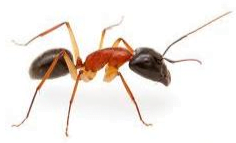
Characteristics
- lack wings
- has three main body parts; head, thorax and abdomen
- has three pairs of legs
- has biting mouthparts
- has a thin waist between thorax and abdomen
- dark-colored for camouflage.
Mosquito

Classification
Kingdom Animalia
Phylum Arthropoda
Class: Insecta
Order: Diptera
Genus: anopheles
Importance of mosquitoes
They transmit diseases.
Table showing diseases carried by mosquitoes.
| Mosquito | Diseases | Causative organism |
| Female anopheles | malaria | plasmodium |
| Aedes | Yellow fever, dengue fever | Virus virus |
| Culex | Elephantiasis | Filarial worm |
The life cycle of a mosquito
Mosquitoes undergo complete lifecycle

Control of malaria
- Sleep in a mosquito net
- Draining stagnant water
- Removing bush in and around the house
- Close the house to prevent entry of mosquitoes
Butterfly

Classification
Kingdom Animalia
Phylum: Arthropoda
Class: Insecta
Order: Lepidoptera
Genus: papilio
Importance
- Pollinate flowers
- Larva stage (caterpillar) are pest
- Larva stage harms human skin
Feeding: feeds on nectar using sucking mouth parts.
Lifecycle: undergo complete metamorphosis i.e. eggs → larva → pupa → adult,
Exercise
1. Which one of the following may not be used to classify insects
A. mouth parts
B. Feeding habits
C. structure of legs
D. Types of eyes
2. Which of the following fins provide major force of propulsion in fish?
A. caudal
B. pectoral
C. Dorsal
D. Pelvic
3. Which of the following diseases is not transmitted by a mosquito?
A. Malaria
B. Yellow fever
c. elephantiasis
D. cholera
4. Which of the following features belong to both Arachnida and Insecta.
A. cuticle and two pairs of wings
B. six pairs of legs and wings
C. Six pairs of legs and antennae
D. Jointed legs and cuticle
5. Which of the following is a respiratory organ in an insect?
A. spiracle
B. trachea
C. Malphigian tubule
D. zygote
6. Which of the following is a characteristic of insects only?
A. Exoskeleton
B. jointed legs
C. two pairs of wings
D. three body divisions
